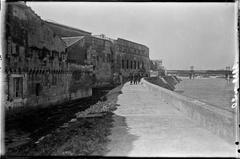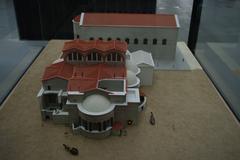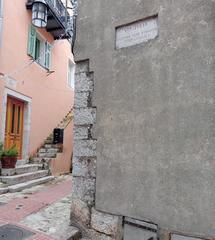Arles Prison Visiting Hours, Tickets, and Guide to Arles Historical Sites
Date: 04/07/2025
Introduction
Arles, a city in southern France celebrated for its extraordinary Roman and medieval heritage, also hosts the Maison d’arrêt d’Arles—commonly known as Arles Prison. While this modern correctional facility stands apart from the city’s iconic monuments, understanding its place within Arles’ social landscape offers a unique perspective on the city’s evolution. This comprehensive guide details the history and role of Arles Prison, clarifies its strict visitor policies, and provides practical information for exploring Arles’ renowned historical sites.
For further details on Arles Prison and the city’s cultural offerings, consult official resources including France.fr, Le Figaro, and the Arles Tourism Website.
Contents Overview
- Historical Development of Arles Prison
- Roman and Medieval Context
- Establishment and Evolution
- Architectural Features
- Layout and Design Philosophy
- Security and Notable Incidents
- 2025 Hostage Crisis
- Security Protocols
- Visitor Information
- Prison Visiting Policies
- Access to Arles Historical Sites
- Travel Tips
- The Social and Cultural Role of Arles Prison
- Arles’ Architectural Heritage: Context and Contrast
- Frequently Asked Questions
- Conclusions and Recommendations
- Sources and Further Reading
Historical Development of Arles Prison
Roman and Medieval Context
Arles’ roots stretch back to Roman times, evidenced by globally recognized sites like the Roman amphitheater and the Alyscamps necropolis (France.fr). During antiquity and the Middle Ages, incarceration was rare; punishment tended to be public and corporal rather than based on long-term imprisonment.
Establishment and Evolution
Modern incarceration arrived in Arles in the late 20th century, as France sought to reform its penal system. Completed in 1991, Arles Prison was located outside the city center to ensure security and separation from the city’s historic core. It primarily houses male inmates serving lengthy sentences, with a focus on high-security and specialized care (Le Dauphiné).
Architectural Features
Layout and Structure
Arles Prison embodies contemporary correctional design, prioritizing:
- High perimeter walls and secured entry points with advanced surveillance.
- Multiple cell blocks grouped by security requirements and rehabilitation needs.
- Infirmary and mental health facilities for specialized care.
- Administrative offices within the protected perimeter.
Design Philosophy
The prison’s architecture emphasizes:
- Surveillance and control for safety and order.
- Segregation of inmates based on risk and treatment plans.
- Spaces for rehabilitation (workshops, classrooms), reflecting modern correctional goals.
Security and Notable Incidents
2025 Hostage Crisis
In January 2025, a prisoner with psychiatric needs took five staff hostage in the infirmary, prompting a major police response. The situation was resolved safely, but highlighted the complex challenges of mental health care within prison settings (Le Figaro; Channels TV).
Security Protocols
- All staff undergo rigorous crisis and de-escalation training.
- Advanced surveillance covers all areas.
- Visits are strictly controlled, with multiple checkpoints and ID verification.
Visitor Information
Prison Visiting Policies
- No Public Access: Arles Prison is not open to tourists and offers no tours.
- Authorized Visitors Only: Access is restricted to approved family, legal representatives, and officials.
- Visiting Hours: Visits are by appointment only and subject to security screening. Hours are not publicly advertised and vary by operational need.
Location and Accessibility
Arles Prison lies several kilometers from the city center and is accessible only via car or local bus (Nomads Travel Guide). The institution has limited facilities for visitors with disabilities, so prior contact with the administration is recommended.
Ethical and Legal Considerations
- Respect for Privacy: Unauthorized visitation, photography, or attempts to observe prison operations are strictly prohibited and may result in legal consequences (Le Monde).
- Media Sensitivity: Coverage of incidents such as the 2025 hostage crisis often sparks public debate over mental health, security, and inmate welfare (Republic World).
Access to Arles Historical Sites
Top Attractions
1. Roman Amphitheater (Les Arènes d’Arles):
- Built in 90 AD, hosts modern events.
- Open daily; tickets: Adults €10, reduced €7, under 18s free.
2. Roman Theatre of Arles:
- Dates to the 1st century BC, still in use.
- Included in combined ticket with amphitheater.
3. Saint-Trophime Church and Cloister:
- Romanesque masterpiece with free entry.
4. Alyscamps Necropolis:
- Ancient burial ground, open daily, free.
(ExploreYourBucketList; Arles Tourism Website)
Travel Tips
- Getting There: Direct trains from Marseille and Avignon.
- Accessibility: Major monuments provide ramps and audio guides.
- Visitor Centers: The Arles Tourist Office offers maps, tickets, and advice.
- Guided Tours: Available in multiple languages, recommended in peak season.
The Social and Cultural Role of Arles Prison
Though not a public site, Arles Prison is a significant local employer and part of the regional justice system. It has been a focus of human rights discussions—such as the 2001 anonymous inmate statement on prison conditions (libcom.org). Its existence draws attention to issues of incarceration, mental health, and reintegration.
The prison’s physical and social isolation affects inmates and their families, often complicating relationships and reintegration efforts.
Arles’ Architectural Heritage: Context and Contrast
Arles’ UNESCO-listed Roman and medieval architecture stands in stark contrast to the utilitarian design of the prison. This juxtaposition illustrates the city’s transition from ceremonial public spaces to secure modern institutions (France.fr).
Frequently Asked Questions
Q: Can I visit Arles Prison as a tourist?
A: No. Only approved visitors (family, legal representatives, officials) may enter, under strict regulations.
Q: What are the visiting hours for Arles Prison?
A: Visits are scheduled in advance for authorized individuals only. No public hours are available.
Q: Where can I buy tickets for Arles’ historical sites?
A: Tickets are available online, at local tourist offices, or at the sites.
Q: Are guided tours available for the prison?
A: No. Guided tours are available only for Arles’ historical monuments.
Q: Is the prison area safe?
A: Yes. The prison is well secured and isolated from tourist areas.
Conclusions and Recommendations
Arles Prison, while integral to the local social fabric, is not accessible for tourism. Its presence provides insight into the city’s contemporary challenges and social structures. For travelers, Arles offers a wealth of accessible and fascinating historical sites, including the Roman amphitheater, Saint-Trophime Church, and the Alyscamps necropolis. Ethical travel emphasizes respect for privacy and lawful conduct, especially regarding sensitive institutions like Arles Prison.
For further travel planning, tickets, and updates, consult official resources such as the Arles Tourist Office and Rencontres d’Arles. Consider downloading the Audiala mobile app for personalized city guides and event updates.
Sources and Further Reading
- Arles Prison: Visiting Hours, History, and Key Information on Arles Historical Sites, 2025
- Arles Prison: Visiting Hours, Tickets, and Its Role in Arles’ Social Landscape, 2025
- Arles Historical Sites: A Visitor’s Guide to Exploring the Rich Heritage of Arles, France, 2025
- Arles Prison: Visiting Hours, Tickets, and Ethical Considerations for Travelers, 2025
- Arles Prison Hostage Crisis Coverage, 2025
- Nomads Travel Guide to Arles, 2025
- Wild Trips: Arles France - What to Visit, 2025
- Rencontres d’Arles Photography Festival, 2025














